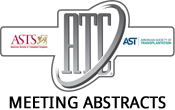2016 American Transplant Congress
Does Rising MELD Score Convey Worse Liver Transplant Outcome?
Surgery, University of Washington, Seattle, WA.
Since February 2002, the Model for End-Stage Liver Disease (MELD) score has been used to allocate liver allografts in the U.S. The aim of this…2016 American Transplant Congress
Review of Aborted Hepatectomy of Liver Transplantation in a Single Center Study.
General Surgery, Samsung Medical Center, Seoul, Korea.
Liver transplantation (LT) has become a popular option for the treatment of endstage hepatic failure. More attention has been given to donor safety, but still…2016 American Transplant Congress
Profiling Immunologic Risk for Acute Rejection in Liver Transplantation: Recipient Age Is a Robust Risk Factor.
Profiling the immunologic risk for acute rejection in liver transplantation (OLT) may allow for selection immunosuppression (IS) target ranges appropriate to risk levels, all with…2016 American Transplant Congress
Increased Frequency of Post-Recovery Liver Reallocation: The Law of Unintended Consequences?
LifeShare of Oklahoma, Oklahoma City, OK.
Background: In June 2013, U.S. liver allocation changed from a local-regional-national model to “Share 35”, broadening sharing to a regional level based upon recipient listed…2016 American Transplant Congress
Outcomes Following Inguinal Hernia Repair in Liver Transplant Recipients.
Surgery, Johns Hopkins, Baltimore.
Liver transplant (LT) recipients are assumed to have poor outcomes following general surgical procedures, which may be a reason why most are directed to transplant…2016 American Transplant Congress
Initial Experience Treating Hepatitis C Positive Kidney Transplant Recipients with Non-Interferon-Containing Regimens: Successes and Challenges.
Weill Cornell Medical College, New York, NY.
Historically, treatment of hepatitis C virus (HCV) infection with interferon-based regimens after kidney transplantation has been associated with risk of rejection & graft loss. Direct…2015 American Transplant Congress
Delivery of Heme Oxygenase-1-Cell Penetrating Peptide (HO-1-CPP) Into Hepatocytes, Kupffer and Islet Cells in In Vitro and Ex Vivo Models of Cold Ischemia
In an attempt to increase the number of donor organs available to transplantation extended criteria donor (ECD) organs are more frequently considered. Unfortunately, ECD organs…2015 American Transplant Congress
Activated Protein C Treatment Protects Steatotic and Non-Steatotic Livers Under Ischemia–Reperfusion Injury in Different Manner
Activated protein C (APC) is known to have the cytoprotective effect on liver ischemia–reperfusion injury (IRI) in rat models. However, it is unclear that whether…2015 American Transplant Congress
Ischemia-Induced Endoplasmic Reticulum Stress Regulates Autophagy to Determine the Severity of Liver Ischemia Reperfusion Injury
Both endoplasmic reticulum (ER) stress and autophagy have been implicated in the pathogenesis of ischemia and reperfusion injury (IRI). As essential cellular stress responses against…2015 American Transplant Congress
Suboptimal Vaccination Coverage After Liver Transplantation: Opportunity for Improvement
Cincinnati Children's Hospital Medical Center, Cincinnati, OH.
Elimination of vaccine-preventable disease after solid organ transplantation (SOT) has the potential to improve outcomes. We evaluated immunization rates and the impact of directed recommendations…
- « Previous Page
- 1
- …
- 45
- 46
- 47
- 48
- 49
- 50
- Next Page »
